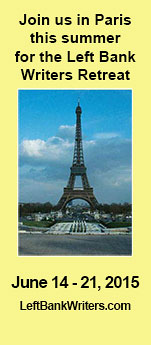|
|
In Paris, sometimes it’s possible to find three bakeries on a single block–they’re omnipresent. When I rented my apartment, I was delighted to find one just around the corner sharing the same courtyard as me. Living near a boulangerie has it’s advantages: five flavors of tarts at your fingertips, plus pain du chocolate always present and the wonderful smell of baguettes baking.
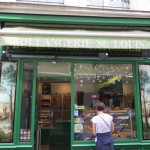
But bakers get to work before sunlight to ensure that warm pasteries are ready for people commuting to work, children on their way to school and locals who stop by each morning for their daily bread. So at around 4:00 a.m., I am awakened by the smell of fresh baking bread, an aroma powerful and inviting, like a cartoon cloud as it curls beneath my nostrils and gently tugs at my consciousness. To be awakened by such a delicious aroma is wonderful, but 4:00 a.m.?
It is formidable to be back in Paris! Here are some changes I’ve noticed since my last visit:
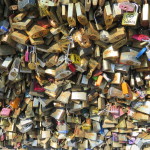
- Love locks: there are even more love locks than a year ago, they are spreading like kudzu, you can feel the poor ponts groan beneath the weight. Paris government is cracking down by removing tons of the locks from the bridges.
- Selfie sticks are partout! Beware as you walk down the sidewalk not to get clobbered by one. Good news, many museums don’t allow them.
- Shakespeare and Company has changed the floor plan of the entrance, when you walk into the store now it feels more spacious and it’s easier to browse the shelves of books.
Things that have remained the same since my last visit:
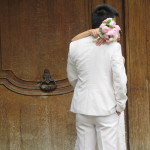
- Wedding portraits on every corner–of course there couldn’t be a more romantic backdrop than Paris.
- The waiters at my favorite café the St. Regis–Alain and company are still there, delivering a café crème to the table toot suite. Forget the old stereotype of the surly waiter, this crew is sympa! (for surly waiters go across the street to the Brasserie.)
- Bouquinistes–the booksellers at their stalls are something you can count on seeing n Paris, like the gargoyles at Notre Dame Cathedral and barges on the Seine.
In Paris, the strawberries are the strawberriest, marvels of sweet red architecture, they melt in your mouth. Tonight, after a busy day, dinner is fromager from the local fromagerie, strawberries from the market across the street, jambon, and a cold Sancerre, plus a great book, The Rocks. Salut!
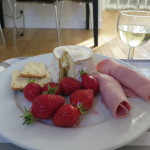
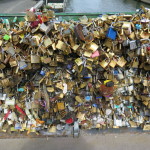 Paris bridges are carrying the burden of lovers The locks of love in Paris–padlocks stuck on bridges and carved with lovers initials–are hurting Paris’s bridges. A grill at the Ponts Des Arts was overladen and collapsed on Sunday, causing the bridge to be shut down. Although it is a charming idea for lovers, it has gotten out of hand and Paris Mayor Anne Hildago is looking for alternatives. Any ideas of what lovers could do to commemorate their time in Paris without hurting a bridge?
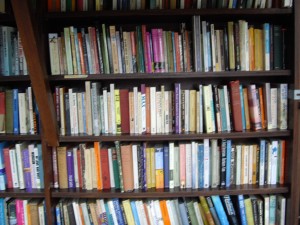 In 2011, books with a French twist top my list of holiday gifts, something for every Francophile whether they’ve been naughty or nice. When possible, please support your local bookstore, but for your convenience, I’ve also added an Amazon link. Below are Frenchophile’s favorites: In 2011, books with a French twist top my list of holiday gifts, something for every Francophile whether they’ve been naughty or nice. When possible, please support your local bookstore, but for your convenience, I’ve also added an Amazon link. Below are Frenchophile’s favorites:
History 1830-1900: David McCullough’s The Greater Journey
McCullough explores American history in Paris between 1830 and 1900 when hundreds of notable Americans like Oliver Wendell Holmes, Mark Twain, Samuel Morse, and Harriet Beecher Stowe–migrated to Paris.
Memoir: John Baxter’s The Most Beautiful Walk in the World
Baxter writers a beautiful memoir about walking in Paris. The best way to see Paris is on foot, and Baxter makes the walk even more delightful with his insights into the stroll.
Humor: Stuff Parisian’s Like: Discovering the Quoi in the Je Ne Sais Quoi by Olivier Magny
Written by the proprietor of O Chateau, a popular wine bar in Paris, Magny’s book is a humorous look into the Parisian mind. This nonfiction book was written in French and translated into English.
Travel: Paris, Paris: Journey Into the City of Light by David Downie
Travel writer David Downie writes thirty-one short prose sketches of people, places and daily life in Paris, and includes photographs by Alison Harris
Fiction: Paris Wife by Paula McLain
A novel that captures Paris in the 1920s, where Hemingway and his wife Hadley live amidst the “Lost Generationâ€â€”that includes Gertrude Stein, Ezra Pound, and F. Scott and Zelda Fitzgerald.
Food: The Sweet Life in Paris: Delicious Adventures in the World’s Most Glorious – and Perplexing – City David Lebovitz
Lebovitz brings us along as he falls in love with the magical, and maddening, city of Paris.
Frenchophile is happy to welcome Lela Lake, who is guest posting for us today. Lela is a life-long lover of Parisian culture who writes for AnyTrip.com, the budget travel specialists. Bienvenue, Lela!
Entertaining yourself in Paris on a budget is a snap if you possess a sense of adventure and an eye for the delights that wait just off the beaten path. Take a different perspective of Paris hunting for gargoyles or sample the eye-popping graffiti and street art that equals – or beats – the glitzy art show venues that cost a pretty penny.
Gargoyle Hunting
 Churches like Notre Dame are bristling with ever watchful gargoyles (photo by Laura K. Gibb) High above the bustling streets of Paris sit thousands of patient gargoyles, silently watching the endless spectacle below. Spotting them from the ground is just the beginning of the fun, figuring out how to get the best angle for a picture to add to your collection presents interesting challenges as well. Note that where gargoyles are present you will usually find a statue of an angel. Local legend claims that the angels took pity on the gargoyles when they fell out of favor with humanity and came to keep them company while they remain in carven captivity.
Digital Journaling
 Create your own digital fine arts collection (photo credit: piC1966) Cataloging your daily adventures in Paris can turn into an adventure all its own with just a little creativity and panache. Write out a daily summary of your unique perspective of Paris for your personal blog or use your digital camera as an excuse to engage people you encounter, snap candid shots of daily life or capture obscure and overlooked beauty. Check around the outside art museums like Le Petit Palais on the Champs-Elysées for available light situations to snap photos of statues since flashes inside are discouraged. Add your digital photos to your online stories or download your favorites onto internet albums like Flickr to share daily pictures of your journey with folks back home or edit them into a video of your most excellent Paris adventure.
Sample Shopping
Huge shopping venues like Galeries Lafayette require no admission but the competition among stores is brisk, so you will find they offer more than mere window shopping to casual passers-by. Simply exhibit the right degree tactful interest and you’ll be inundated with offers to sample products, nibble delicacies, watch fashion shows while sipping champagne or even have experts help you browse their selections to find what type of look works best for you. The chic part is realizing that you can have all that pampering without actually opening your pocketbook.
Street Art Walk
 (photo credit: a-m-a-n-d-a) Some argue that the best contemporary art in Paris is not in the galleries but painted on the walls throughout the city. To see the biggest conglomeration of graffiti art, head to the Belleville – Menilmontant section during the day to get an eyeful of the vibrant colors and themes that have made this an art form a reluctantly respected genre.
Sunset Picnic at the Cemetery
Spooky even in the daytime, the great mausoleums within the Père Lachaise Cemetery become positively eerie as the sun slowly sets over the Seine and city lights begin to fill the night. Just bring along your blanket, a basket of nibbles and maybe a nice bottle of wine and prepare to sit quietly. Resist the urge to chatter or fuss with your phone to experience the full chilling effect of the shadows lengthening behind the tombs and sunset painting the marble headstones in exquisite colors as the shadows deepen.
Thanks for these great ideas, Lela! Check out AnyTrip’s competition to win a trip to Paris (ends September 30, 2011) or browse their selection of cheap hotels in Paris.
I don’t recall when I first dreamed of visiting Giverny—maybe as a college student looking at art books? Could the inspiration of Monet’s Water Lilies (Nympheas) be as beautiful or the colors as vibrant as the paintings? I wanted to experience it firsthand: the dappled light of the forest, clouds reflected in the pond, the lush green lily pads.Â
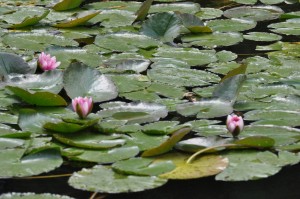 Photo by Kenneth Cohen On previous visits to Paris, regrettably, I didn’t make it to Giverny. But I did visit the Musee de L’Orangerie in the Tuileries, to see Monet’s Water Lilies up close. Built in 1852 as a hothouse for the King’s potted orange trees in winter, the Orangerie was Monet’s choice as a home for his masterpiece. The architect Camille Lefèvre was commissioned to renovate the building to accommodate the massive canvasses—1,950 feet of canvas—that Monet painted at his home in Giverny in a special studio with skylights and wheeled easels to accommodate the canvases. The water lilies in all their magnificence surround the oval shaped room just as they might have done around the pond.
 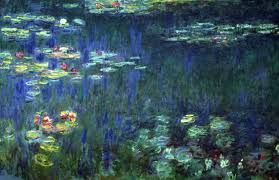
During this visit to Paris, though, Giverny was at the top of my “bucket list.â€Â Only 45-minutes to Vernon on the speed train and then a bus ride from Vernon to Giverny will deliver you to the garden gates. Despite warnings about the long lines, we arrived in Giverny and there only five people in front of us at the ticket counter. Within minutes we were touring Monet’s maison— standing in his lovely living room on the groundfloor, examining his cozy kitchen and looking out the window from his upstairs bedroom onto the gardens below. Did he actually stand here where I’m standing I wondered. Below, lilies, roses, poppies, daisies in red, purple, orange, and fuschia flourished in the garden near the house. Then by walking across the road we reached the lily pond.
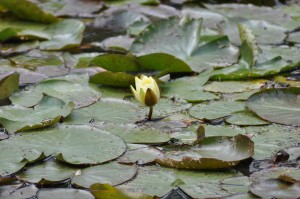
Although we were surrounded by busloads of tourists and a group of rowdy preschoolers at the pond—there was a calm there, it felt so quiet and peaceful. I could have spent hours there. But the shuttle awaited us, and we didn’t want to miss the train back to Paris, so off we went feeling refreshed after a day in Monet’s garden.
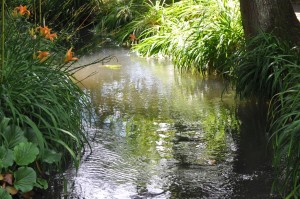 Photo by Kenneth Cohen
After Ken and I finally stumbled upon the “G.H. Martel Champagne” sign, we entered a charming office that looked like someone’s living room to wait for the tour. In Reims we had eaten lunch at a brasserie and noticed two young women sitting next to us eating what appeared to be a delicious lunch.  They walked into the room a few minutes later to join the tour. Fancy meeting you here we joked.  They were from Sydney and one of them is in Paris studying and her friend from Sydney is visiting her. A couple from Sweden joined the group and our tour guide, Sophie, lead us to the entry way to the cave.
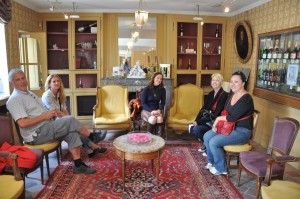 A Merry Group We walked down steep stairs to a basement like room that had been dug out of solid chalk. We walked down steep stairs to the cave made out of chalk and learned that hundreds of years ago the chalk caves in Reims were used to store foods—for refrigeration—because they maintain a constant temperature. The fact that Reims is built on chalk is one of the reasons it became the champagne capital—winemakers discovered they could store the bottles here in a perfect constant temperature. We saw the antique equipment that has been used in the process when it was all done by human labor before it became modernized at their operation in Epernay, another Champagne center. Women were not allowed to be involved in the process except for one job: attaching the labels.
The champagne process takes so much work and it amazes me that someone figured it out. First they make the wine, then add the sugar and yeast, then turn the bottles, then disgorge the sediment, then add a little more wine, then put a cork on it. Voila! Who figured out that you could get rid of the yeast sediment by freezing it in the neck and then opening the bottle?
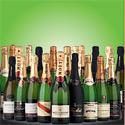
During WWII 120 hid in G.H. Martel’s Champagne Cave. People have also come here alone to have a toast before their wedding for good luck. Our guide Sophie told us that “champagne cellars are a cathedral underground.†This cellar, although dark and damp, did possess the calm that one finds sitting in a church.
This year is an exciting year in Champagne making because it may produce a “vintage year.†The last vintage year was 2004—this is when the conditions are so perfect that 100 percent of a grape is used in the champagne—there’s no mixing of different grapes. Because April and May were unseasonable warm this year, followed by a very cool, rainy June, champagne makers are hoping that this will be a very good year for the grapes.
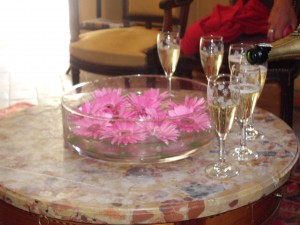
The tour ended back in the living room where we sampled three generous glasses of champagne: Coeur de Cuvee made from chardonnay, pinot noir, and pinot menier; Grand Cru made from pinot noir (90 percent) and chardonnay (10 percent) and the Bouzy Rouge made from pinot noir grapes.
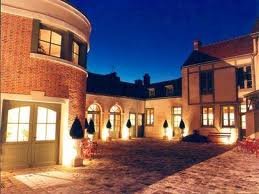
We said goodbye to our new friends and boarded the high speed train back to Paris–it was a perfect day trip to Reims.
There are two types of people in the world: those who love looking at ancient cathedrals and those who would much rather tour a champagne cave. But I learned, surprisingly, that I like both! Today we took the high speed train from Paris to Reims, one of the two main champagne regions of France, with the intent of touring the G.H. Martel Champagne Cave. But we arrived at 10:30 a.m.with time to explore the town of Reims (pronounced “rance†which rhymes with France, go figure) before sampling the bubbly.
Reims is a spectacular town where 26 kings were crowned, where champagne was invented, and where the Germans officially surrendered in WWII. It’s known for the spectacular cathedral in the city center where Clovis, the first King of the Franks, was baptized at a church on this site in 496.Â
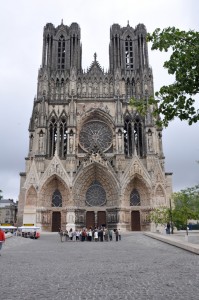 Notre Dame de Reims Ken and I wondered through town, unable to locate the proper bus stop to the cathedral. We meandered from block to block and finally asked a bus driver. “Ou est l’autobus pour Cathedral.â€
“Cathedral?†he asked, then pointed “A gauche.†(to the left.) We had to laugh, we were a block away from the cathedral—no need to take a bus.
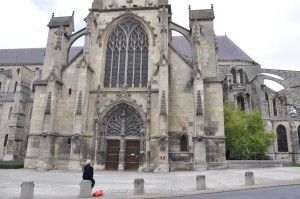 Please let me in The cathedral is impossible to miss–it is the heart of the city. Construction on Cathedral Notre Dame de Reims began in 1211 and it’s mind boggling to imagine the workers who built this masterpiece. Many of the stained glass windows were destroyed in WWI and have been replaced by local Champagne makers—the windows show scenes portraying the tending of the vines, the harvest, and the fermentation process.Â
Next, we look for a bus to the Martel Champagne Cave. In Paris, everyone speaks some English and I’ve never had a problem communicating. Outside of Paris, however, not everyone speaks English, especially not bus drivers. When we asked our bus driver “Ou est la Martel Champagne Cave?” He gave me a blank look and then I pointed at the name in the guide book.  He said his bus didn’t’ stop there but he would show us. We drove through town and at a top of a hill he stopped and set the brake, with a full bus no less, got out of the bus and walked down the block with us to show us the correct bus stop. But as we waited for the bus, we looked up and saw a sign down the street G.H. Martel Champagne Caves. We had arrived and didn’t realize it.
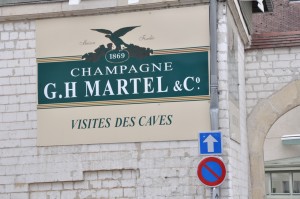
The Caves were closed for lunch so we explored the neighborhood and discovered another spectacular Cathedral, the Saint Remi Basillica. We walked around the grounds and took photos—it was a quiet, lovely place with an ancient forrest of moss covered trees beside it.
Finally at 2 PM we arrived at the Champagne caves for our tour. Stay tuned for Part II of the Champagne Cave Tour in a future post.
Enough talk about the rain in Paris, suddenly there’s a heat wave coming to town with the hottest day of the summer predicted for tomorrow (100 degrees Fahrenheit.)Â
Anna returned to the U.S. yesterday so on this Sunday morning, Ken and I awoke with a sunny day in front of us and decided to rent bikes on Velib and ride to the street market on Rue Cler. Sundays are my favorite days to rent bikes in Paris because there’s less traffic, and the road along the Seine is closed to cars and open strictly for pedestrians and bikes.
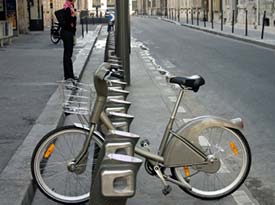 Velib Velib can be tricky the first time you use it but with patience it is a very easy way to rent bikes. Be sure to check out the condition of the bike before you take off with it. The first bike Ken had was stuck in first gear and the seat was broken so we had to return it and get a new one. The first half-hour is free so it wasn’t a problem to exchange.
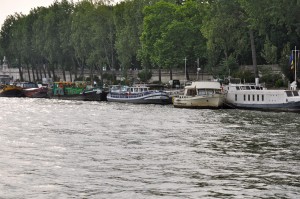
We rode past the houseboats on the Seine, some of them are private residences and some are commercial ventures offering dinner and some providing guided tours. Near the Eiffel Tower we merged back onto street traffic before turning onto a tree-lined path at the Champs de Mars. It was a typical Parisian Sunday with families were picnicking, mothers pushing babies in strollers, children riding bicycles. Nearby we turned onto Rue Cler for the outdoor market. It was nearly 1:00 p.m., late for the market as stalls were being packed up. So we locked our bikes to a post and took a seat in the shade at the Market Café. Our lunch was superbe: Ken’s organic eggs benedict with lean bacon strips had the best hollandaise sauce I’ve ever tasted. My caprese salad was prepared perfectly with the tomatoes arriving whole, seeded and peeled atop a chunk of mozzarella with basil aioli drizzled over them.
 Rue Cler It was two o’clock, getting warmer by the minute when we arrived at Velib to return our bikes but yikes, there were no empty spaces. We had a choice. We could lock them up and pay for additional time while we rested in our air conditioned hotel room or we could keep riding to look for spots to return our bikes. Our air-conditioned hotel room called to us. We would try again later when we would need to go out for our daily ice cream at Berthillon. As the French say, “Cest la Vie.â€

|
|
























